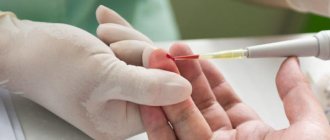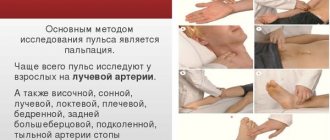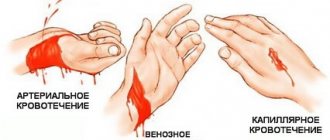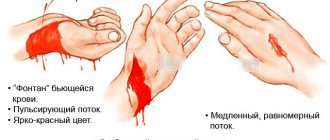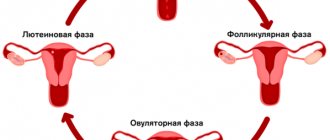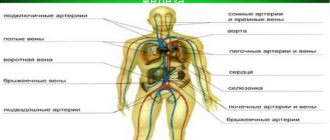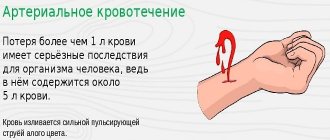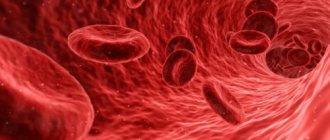Tactics for venous bleeding
With venous bleeding, blood loss occurs a little more slowly, but there is a high risk of air getting into large veins.
When a vein is damaged, the air that has entered it is converted into small bubbles that quickly move towards the heart or brain. If they reach one of these organs, an embolism (blockage of blood vessels) will occur, which in most cases leads to the death of the patient. If blood loss from a vein is detected, you need to proceed according to the following scheme:
- Treat the wound with disinfectants;
- Shape the gauze or bandage into a tampon by rolling it in several layers;
- Place a clean cloth on top of the tampon, securing it with a wide bandage so that it is not on the damaged area, but around it;
- Make sure the bandage is applied tightly enough. Then it will help connect the torn edges of the vein.
Most often, such methods are effective and quickly eliminate bleeding. However, if a deep vein is ruptured, the above measures do not produce results: rapid blood loss continues. Only in this case, in case of venous bleeding, use a tourniquet! If during arterial bleeding a tourniquet is used above the site of injury, then venous injuries require the opposite location: under the wound
This feature is associated with the functional responsibilities of the veins, because the blood in them moves from bottom to top, that is, directly to the muscles of the heart, and not from them. When using this device, it is important to remember that applying it to unprotected skin is unacceptable! Any material can be used. If there is not a single piece of clean fabric, you can use elements of the victim’s clothing for these purposes.
Algorithm for using a tourniquet for bleeding from a vein:
- Without pulling, bandage the limb loosely with the device;
- Slide a tube or stick under it;
- Taking both ends of the tube, begin to twist the tourniquet until you achieve optimal compression.
Important information
We have already mentioned that a tourniquet is used only in exceptional cases, since its incorrect use will cause irreparable harm to the patient
Therefore, it is important to be able to determine that the hemostatic tourniquet is applied correctly
If the device is applied correctly, the following factors are noted:
- Blood loss stops;
- The skin becomes pale in the place where the tourniquet is located and above;
- There is a clear pulsation in the area below the blocked artery.
- If there is no pulsation, this indicates excessive compression of the artery. In this case, the device should be relaxed.
- No less important is the factor for how long the tourniquet is applied: prolonged occlusion of arteries or veins leads to complete tissue necrosis. That is why an important condition after the event is to write a note indicating the time when the device was secured. In the event that there is no paper and pen to make the necessary notes, the time is written in the patient's blood on his face or limb. This indication will be the deciding factor for medical personnel for further emergency action.
- The critical maximum for a tourniquet to be on the human body is half an hour in winter and an hour in the hot season. If medical help does not arrive during this time, the tourniquet is loosened or removed by squeezing the artery with a finger.
- The next bandage is applied no earlier than 15 minutes after the previous one. At the same time, the time of its use should also not be more than 15 minutes.
Correct use of a tourniquet is sometimes the only way to save a human life. Therefore, in such an emergency situation, you need to act without panic and quickly, following the order of the above actions.
How to properly apply a tourniquet
Any injury is usually accompanied by bleeding. In this case, severe blood loss often poses a greater danger to the life of the victim than the injury itself.
There are several ways to stop bleeding, each of which is used in a specific situation. A tourniquet is used in exceptional cases when a large artery is damaged or other methods to stop blood loss were not effective.
With severe blood loss, there is no time to think, so it is important to clearly know how to apply a tourniquet correctly, because the slightest mistake will threaten the victim with amputation due to tissue death.
Considering that, depending on the type of bleeding, there are 2 methods of using a tourniquet, it is necessary to clearly distinguish between the types of blood loss.
Features of the procedure
The most powerful car in the world can travel more than 400 km/h.
As already mentioned, a tourniquet is not applied for capillary bleeding (except in cases where the patient has reduced blood clotting).
The most dangerous are arterial hemorrhages, which can cause heavy blood loss and death in 3 minutes.
To temporarily stop blood from a vein, finger pressure is used. The limb is raised, the wound is covered with a tampon, which is fixed with a pressure bandage. If after these manipulations the blood does not stop or the bleeding is severe, then a tourniquet is applied under the wound.
To stop arterial hemorrhage, the method of finger pressure is also used, and only after that more drastic measures are used (application of a hemostatic tourniquet or a pressure bandage).
To stop the bleeding temporarily, you need to know the location of the arteries well and know where they can be pressed against the bone:
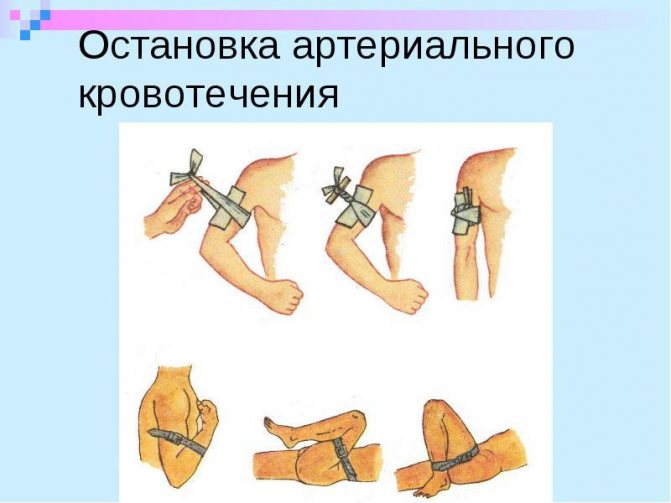
During digital pressure, apply a pressure bandage or tourniquet.
Age restrictions
If the child is under 3 years old, then applying a tourniquet to any part of the body is strictly prohibited! For such babies, only pressing the vessel with a finger is used. Upon reaching the age of three, the maximum time for applying a tourniquet is 60 minutes in the summer. In this case, you need to loosen the tourniquet for 5 minutes after half an hour. In winter, for children over 3 years of age, the maximum time for applying a tourniquet is only 30 minutes.
For older people there are no time restrictions. Therefore, for them the maximum time for applying a tourniquet is standard.
It is not uncommon for a person to be injured with subsequent loss of blood; in special cases of heavy bleeding, the ability to apply a tourniquet may be necessary.
Bleeding is a condition of the outer epidermis when the integrity of the epithelial layer collapses and blood rushes into the external environment. How much blood a person will lose depends on the type of damaged vessel and the extent of its damage. Blood loss is minimized when capillaries are damaged, and the greatest amount of blood loss can be observed when an artery is damaged.
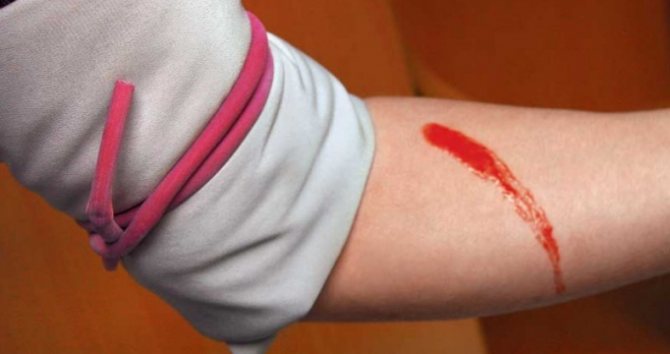
A tourniquet is a tool that makes it possible to stop bleeding in the first place. This happens by pulling the damaged limb above the damaged area, squeezing nearby tissues and blood vessels. The reason for using a tourniquet can be safely called temporary blockage of veins and arteries. If the tourniquet is not applied in a timely manner, the likelihood of death increases significantly.
Read more: The principle of operation of hubs on UAZ
Features of determining the type of bleeding
Is it legal to drive on winter tires without studs in the summer in 2017?
Signs of damage to large vessels:
- The location of the wound surface in the area of a large vessel. Typically, these are injuries affecting any limb, head and chest.
- Obvious severe external bleeding from a vein or artery.
- Formation of strong and extensive hematomas at the site of injury.
- Strong pulsation of the injury site and hematoma area.
- A marked decrease in the pulsation of blood vessels below the site of injury.
- Pallor and cyanosis of the injured limb.
- Reducing the temperature of damaged areas.
- Impaired functioning of damaged limbs and other parts of the body.
Arterial blood can be easily distinguished by its scarlet color. A very strong pulsation is observed in the damaged vessel. The blood flows out under increased pressure, expressed as a stream, and flows in the form of a fountain. Arterial bleeding is always characterized by very high intensity and strength. Internal bleeding from the arteries is accompanied by the formation of bruises and hematomas that cover the entire circumference of the limb.
Venous bleeding is distinguished by dark blood. It flows out of the vessel slowly, as if it were just pouring out. The stream is often intermittent. Injuries to large veins in the neck, chest and pelvis are more dangerous than injuries to arteries. Often, assistance to the victim and a tourniquet will be required even for small and medium-sized vein injuries.
What are the types of bleeding?
Hemorrhage is distinguished by the area of leakage:
- Internal - blood flows into the body and forms a hematoma.
- External - flows out.
Depending on the type of damaged vessel, bleeding occurs:
- Capillary. The safest and slowest. Blood elements usually form a clot themselves and thereby stop the bleeding. But it can also be life-threatening - in diseases that provoke a decrease in the function of coagulation in the blood (for example, hemophilia or von Willebrand disease).
- Arterial. The pulsation of a bright red blood stream is characteristic. This species is the most dangerous for life, because it leads to huge losses of blood supply in a short period of time. Consequences: pale blood, weakened pulse, low blood pressure, dizziness, gag reflex. If blood stops flowing to the brain, instant death occurs.
- Venous. Dark burgundy blood flows out smoothly, with only a slight pulsation possible. If a significantly large vein is damaged, then when you inhale, a negative pressure effect appears in the vessel with an increased risk of air embolism in the heart vessels or in the human brain.
Read more: Is it possible to restore a car registration certificate?
Internal bleeding and its intensity are accurately determined only with the help of special equipment.
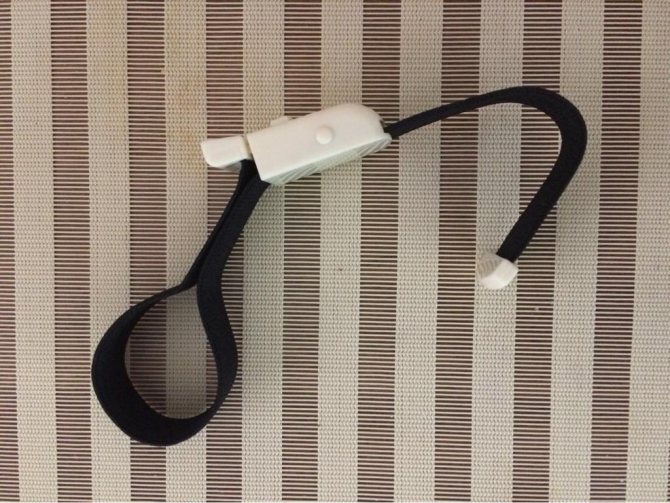
Methods for finally stopping bleeding are mechanical, physical, chemical and biological.
The car stalled while driving and will not start. What is the reason
Methods to finally stop bleeding
(Operation procedure)
The final stop of bleeding can be mechanical, physical, chemical and biological.
Mechanical methods to stop bleeding
are performed in a dressing room or operating room during surgical treatment of a wound or during an operation and consist of the following:
a) clamping of the vessel with a clamp followed by application of a ligature;
b) in case of danger of the ligature slipping, they use the method of puncturing the vessel, i.e., before tying, the thread is passed through the wall of the vessel or the surrounding tissue with a surgical needle and then passed around the vessel and tied;
c) ligation of the vessel along its length.
In case of diffuse bleeding from a wound, when it is impossible to stop the bleeding even by suturing the tissues in the mass, the method of ligating the vessel feeding this area throughout is used. To do this, the vessel is exposed with a separate incision above the wound and bandaged.
In case of injury to large great vessels, the preservation of organ viability depends on the duration of ischemia. As is known, irreversible changes begin 2-4 hours after the onset of ischemia, therefore, when stopping bleeding in order to preserve the viability of the limb (temporary restoration of blood supply), the method of temporary intravascular bypass is used. The technique is simple and consists of introducing any densely elastic tube into the lumen of the damaged artery and fixing its ends with ligatures. Such a “shunt” can function from several hours to a day.
The ideal way to stop bleeding when large vessels are damaged is a vascular suture, which restores the continuity of the vascular bed. A necessary condition for applying a vascular suture is the presence of vascular clamps, atraumatic needles and the surgeon’s knowledge of the vascular suture technique.
There are two types of vascular suture: lateral and circular. A side suture is used for marginal wounds of a vessel, performing longitudinal (if the size of the vessel lumen allows) or transverse suturing of the lumen. In case of a marginal defect of the artery, a patch made of autovein or synthetic material can be used to replace it. In case of a complete break or intersection of the artery, its ends are isolated and two atraumatic sutures are placed in two opposite edges of the vessel, the latter are brought together, the sutures are tied and used as holders, the edges of the vessel are sewn together with a continuous wrapping suture. If there is a significant defect in the vessel, its continuity is restored with an alloprosthesis. When applying a vascular suture and there is no vascular needle holder, a direct clamp can be used.
Physical ways to stop bleeding
consist in the use of high and low temperatures. The hemostatic effect of high temperature is based on its contracting effect on the vessel, and at significant levels, tissue proteins and blood coagulate. For this purpose, an isotonic sodium chloride solution is most often used, heated to 45-50 ° C. Currently, electrocoagulation has become widespread - one electrode of the coagulator in the form of a lead plate is tightly fixed to the limb through a gauze moistened with an isotonic sodium chloride solution, the second the electrode is free, and when it touches the hemostatic clamp, coagulation of the vessel occurs. In medical practice, a laser beam has begun to be used as a scalpel, which allows bloodless surgery. Low temperature acts similarly to high temperature, causing spasm or tissue coagulation depending on the magnitude. For this purpose, ice, crystallized carbon dioxide (dry ice), and liquid nitrogen are used.
Chemical methods
are divided into external and internal hemostatic agents. As an external agent, a 3-5% solution of hydrogen peroxide, a solution of adrenaline 1:1000, etc. are used. Internal agents consist of two groups: those that cause vascular contraction (ergot preparations, adrenaline, norepinephrine, mesaton, etc.) and those that increase blood clotting (vicasol, calcium chloride, gelatin, aminocaproic acid, hemophobin, etc.).
Biological methods of stopping bleeding are based on the external and internal use of blood products and its components (hemostatic sponge, fibrin film, fractional transfusion of small doses of blood, fibrinogen, fresh plasma).
Bleeding and stopping it
When bleeding, especially arterial bleeding, you cannot waste a minute, including searching for standard means to stop the bleeding.
Depending on the type of bleeding, different rules and methods of stopping it are used.
5.1.
Arterial bleeding
Signs:
- scarlet color of blood;
- the blood flows in a stream with intensification during the pulse impulse.
Ways to stop arterial bleeding
1. The very first and simplest method is finger pressure on a bleeding vessel or wound tamponade.
Pressure is carried out with a finger or fist above the bleeding site on the limbs, below - on the neck and head. Hold until the bleeding stops or until other methods are used to stop it. The method is short-term, since it is difficult to continue pressing the vessel for more than 15-20 minutes.
2. Application of a hemostatic tourniquet
– this method should be used as rarely as possible and only in cases where all other methods of stopping bleeding are ineffective. The place where the tourniquet is applied is chosen so that it is located closer to the heart relative to the location of the wound. A pad made of any soft tissue is placed on the intended site of application of the tourniquet and the tourniquet is applied with such force that the bleeding stops
Rules for applying a tourniquet:
- wrap the tourniquet around the limb and stretch it;
- press the first turn with maximum force. The criterion for correctness is stopping bleeding;
- apply the next turns with less force;
- fix the tourniquet and include a note with the time of application.
- apply an aseptic bandage;
- in winter, wrap a limb;
- time to apply a tourniquet is no more than 1.5 hours in summer, 1 hour in winter.
Delivery to the hospital: the sooner the better. In case of blueness and swelling of the limbs, the tourniquet should be immediately removed and reapplied. If the maximum tourniquet application time has expired and medical assistance is not available, do the following:
- press the artery above the tourniquet with your fingers;
- remove the tourniquet for 15 minutes;
- massage the limb if possible;
- apply a tourniquet slightly above the previous application site, if possible.
In the absence of a standard (service tourniquet), you can use a twist tourniquet:
- apply a twist tourniquet from available material (fabric, scarf) around the limb above the wound, on top of clothing or placing fabric on the skin;
- tie the ends of the fabric in a knot to form a loop;
- insert a stick (pencil or any similar object) into the loop so that it is under the knot;
- rotate the stick, tightening the tourniquet until the bleeding stops;
- secure the stick to prevent unwinding;
- all other rules are the same as for a standard harness.
When applying a tourniquet, DO NOT:
- waste time taking off clothes,
- apply a tourniquet without a soft pad,
- apply a tourniquet below the elbow and knee.
3. Method of maximum limb flexion
1. Place a roller on the inner surface of the limb.
2. Bend the limb as much as possible through the roller and secure with a belt or bandage with strong tension (arm at the elbow, leg at the knee)
3. Fixation time – 1.5 hours.
IT IS FORBIDDEN:
use this method for fractures.
5.2
.
Venous bleeding
Signs:
a) dark red color of blood with a bluish tint.
b) is characterized by a “swelling” of blood from the depths of the wound and the absence of pulsation; it flows out slowly, in a stream without shocks
Rules and methods of stopping:
tight pressure bandage with wound tamponade.
Apply a tampon to the wound, bandage it tightly to the affected part of the body and thus completely stop the bleeding. This method is called the "pressure bandage" method.
, it turns out to be almost always sufficient to stop venous bleeding.
IT IS FORBIDDEN
apply tourniquets for venous bleeding.
5.3. Capillary bleeding
Signs:
The color of the blood is red, there is no pronounced stream, the entire wound surface bleeds.
Rules and methods of stopping
:
pressure aseptic dressing.
Rules for applying bandages:
- primary wound cleaning - remove easily accessible foreign bodies;
- treat the wound: with a solution of hydrogen peroxide (H2O2) 3%, wash the wound surface with a swab and dry;
- Apply a sterile napkin to the wound and bandage it tightly.
Bandaging is done according to the rule of eights. The aseptic dressing is applied tightly, the main task is to hold the napkin on the wound. Bandage with force until the bleeding stops.
5.4. Bleeding from the nose.
- If there is a nosebleed, sit the victim down, tilting his head slightly forward. Squeeze the wings of your nose for 15-20 seconds. In this case, the victim must breathe through his mouth.
- Apply cold to the bridge of your nose (wet handkerchief, ice, snow).
Errors when providing assistance
A person providing assistance may make a number of mistakes when using a hemostatic tourniquet. The most common errors are :
- Applying a tourniquet directly to the skin without a tissue layer. This leads to pinching of the skin, which leads to pain, bruising and soft tissue necrosis;
- The tourniquet is hidden under clothing , a bandage, a blanket, and so on. In this case, people or health workers who will continue to provide assistance may simply not immediately see the tourniquet. As a result, it will remain on the body longer than necessary with all the ensuing consequences;
- Keeping the tourniquet on longer than the maximum allowed time. In this case, there is a persistent disruption of the nutrition of soft tissues, which leads to their death (necrosis);
- Placing the harness in the wrong place. In this case, increased bleeding or nerve damage may occur, followed by paresis or paralysis of the limb;
- There is no note with the exact time of application of the tourniquet. In this case, it is easy to overexpose the tourniquet and necrosis will develop.
Read more: Good description of a car for sale
Consequences of bleeding in the absence of first aid
If a tourniquet is not applied to the patient in time, the likelihood of severe blood loss increases. Because of this, the pressure in the arteries drops, the concentration of hemoglobin in the blood decreases, and the brain bleeds.
If medical care is not provided in a timely manner, there is a possibility of death of the victim due to bleeding of the body.
With slow and constant bleeding, which can last several weeks, anemia develops.
Due to large blood losses, the activity of the heart and blood vessels is disrupted. Against the background of insufficient blood circulation to the brain, the functioning of the central nervous system is disrupted.
Based on all of the above, bleeding is a dangerous injury that can be fatal.
That’s why it’s so important to learn the rules for applying a hemostatic tourniquet in order to provide timely assistance and save a person’s life.
It should be emphasized that the application of a hemostatic tourniquet
- forced, very traumatic medical manipulation.
It can be used in cases where other methods of emergency temporary stopping of external arterial bleeding from the great vessels of the extremities are not effective or possible and requires the person providing assistance to strictly adhere to the following rules: - the tourniquet is applied to
clothing or a soft lining, which avoids damage to the skin and reduces the pain of the procedure; - a tourniquet is applied above the wound and as close to it as possible to limit the area of bleeding of the limb; -
stopping bleeding
is achieved by the first round of the tourniquet (compression of the soft tissues of the limb with a tourniquet should not be excessive, otherwise additional tissue damage is possible); - main signs correctly applied tourniquet: 1. cessation of pulsation of blood vessels below the applied tourniquet; 2.
stopping bleeding from the wound; 3. pallor of the skin. - subsequent rounds of the tourniquet should be applied in an ascending spiral (the human limbs have the shape of an inverted cone), each subsequent tour should cover the previous one (this is impossible when applying a tourniquet to the limbs of an obese person, or to the thigh), ensuring that the achieved level of compression is maintained arteries, as well as creating a wider zone of soft tissue capture, which somewhat reduces pain in the wounded; - the tourniquet must be fixed
on the limb by using the latches or a chain with a hook on it, or tied into two knots; - the tourniquet must be clearly visible, it should not be hidden by a bandage or immobilizing splint (it is possible to write “TRAVINET!” on the forehead of the wounded person) ;-
it is necessary to indicate the exact time
of application of the tourniquet in the accompanying documents: the period of safe stay of the tourniquet on the limb is no more than 1 hour, regardless of the time of year and ambient temperature; if the evacuation time takes a long time, the tourniquet must be loosened by 10 under visual control -15 seconds and tighten again, but for no more than 20 - 30 minutes due to pain at the site where the tourniquet is applied; -
after applying the tourniquet,
it is necessary to administer painkillers (Promedol 2% - 1 ml from a syringe tube), apply transport immobilization; - the wounded limb must be covered with ice (cooled), and the patient must be warmed (give plenty of hot, sweet drinks to replenish fluid and energy losses); - a wounded person with a tourniquet is considered a patient with unstoppable bleeding and
must be evacuated first
(preferably by air , preferably with an accompanying person). The sequence of first aid at the site of injury for external bleeding is shown in Figure 11.
Failure to comply with these rules can result in fatal consequences. As a clinical observation, we give an example of incorrect application of a standard hemostatic tourniquet.
Clinical example
Captain N., born in 1974, was delivered to the emergency department of a military hospital in Vladikavkaz on November 19, 1999 at 1:35 p.m., with a through-and-through bullet wound to the left popliteal region.
As a matter of mutual assistance, a standard rubber tourniquet was applied to the middle third of the left thigh. The tourniquet was applied
directly to the cotton pants, ineffective, and the bleeding continued. He was transported to the hospital in agony. Resuscitation measures are not effective. Death from acute massive blood loss was diagnosed.
Don't Make These Mistakes When Applying a Tourniquet
When using a tourniquet, the following mistakes should not be made, since making them is dangerous to the health of the victim:
- clothing over the tourniquet;
- use without indications;
- insufficient consolidation;
- applying a tourniquet to the skin will damage it;
- a tightly tightened tourniquet threatens limb necrosis;
- a poorly tightened tourniquet is ineffective,
- bleeding will continue; there is no mark on the application time.
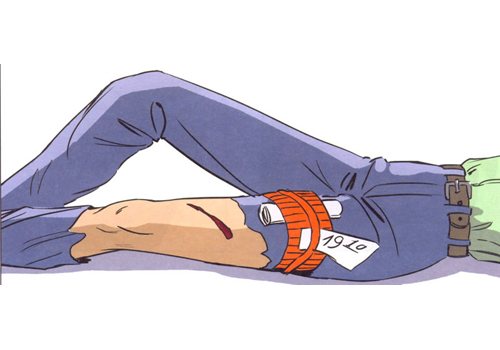
Applying a tourniquet for arterial bleeding
Stopping bleeding from an artery by applying a tourniquet is a temporary method of stopping bleeding. The task of everyone who helps the victim is to correctly perform the technique of applying a tourniquet and ensure the delivery of the wounded person to a medical facility.
A tourniquet should be applied only in case of severe arterial bleeding. In all other cases, you should try to stop the bleeding with digital compression or a pressure bandage. A pressure bandage is made in case of arterial bleeding from a whole roll of sterile bandage, which is tightly fixed to the wound surface.
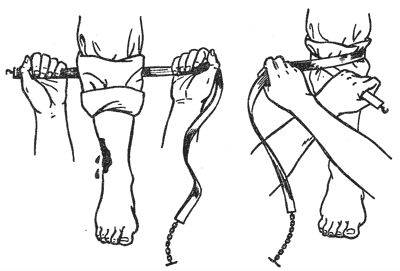
If the rules for applying a tourniquet are violated, sad consequences may occur: necrosis, gangrene, damage to nerve trunks
This is especially true for the shoulder region, because the radial nerve is located superficially there. A tourniquet is applied to the middle third of the shoulder only as a last resort. It is better to choose a place higher or lower. One of the available means can be used as a tourniquet: a wide rope, a belt or a scarf.
Attention! A homemade tourniquet should not be too thin, as this can cause tissue necrosis.
So how to apply a tourniquet during arterial bleeding so as not to harm the patient in the future? By remembering a few basic rules, you can avoid a lot of mistakes.
The algorithm for applying a tourniquet is as follows:
- Select a place to apply the tourniquet. It is located above the site of damage, but as close as possible to it (the optimal distance is 2-3 cm). We should not forget about injuries to the neck and head - there a tourniquet is used below the wound. If the femoral artery is damaged, it is compressed at the level of the middle third of the thigh, and if there is bleeding from the arm, it is compressed in the upper or lower third of the shoulder.
- Wrap the selected area with cloth, gauze or bandage.
- The limb should be in an elevated position.
- The tourniquet is stretched and made several turns around the limb. In this case, its first turn is made with greater, and all subsequent turns with less effort. If large arterial trunks are damaged, for example, the femoral artery, it makes sense to apply two tourniquets - one higher, the other lower.
- Its ends are tied into a knot or secured with a special chain or hook.
- The correct application of the tourniquet is checked: pulsation of the injured artery below the injury is not palpable, and bleeding from the wound stops.
- The exact time of application of the tourniquet is recorded. This can be done on a piece of paper, which is inserted under the tourniquet itself, directly on the patient’s body near the site of injury, or on clothing.
- An aseptic bandage is applied to the wound.
In case of injuries to the carotid artery, the tourniquet is applied below the injury, but it should not compress the artery of the same name on the other side. To do this, a tight roller is applied on the side of the injury, and a tourniquet is fixed on the opposite side through the patient’s raised arm and an attached flat board.
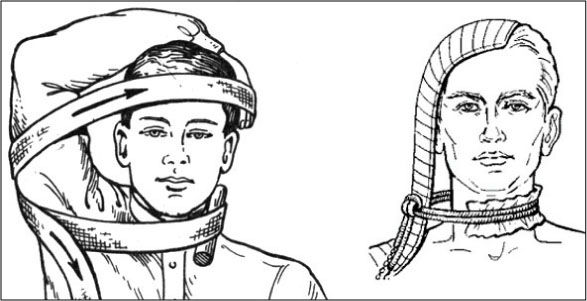
Correct application of a tourniquet according to Mikulicz for injury to the carotid artery
The tourniquet should not be applied too tightly, since applying the tourniquet correctly means applying minimal pressure to stop the bleeding. In this case, the blood supply should be carried out through deep arteries and veins, and in no case should it stop completely.
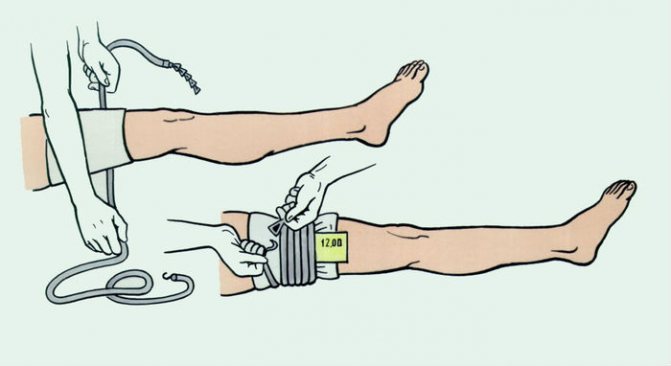
If the tourniquet is applied too tightly, it can lead to necrosis of the limb, followed by amputation.
The time factor is also important here. The maximum time for applying a tourniquet varies depending on the ambient temperature:
- in summer - for 1 hour;
- in winter - for 30 minutes.
If a longer time interval is required to transport the victim to the nearest hospital, the tourniquet is temporarily removed, switching to 10 minutes of finger pressure. Then you need to apply a tourniquet again according to the rules described above.
Twist tourniquet
In the absence of a special tourniquet, you can use an improvised twist tourniquet. To form it, you need to take a wide ribbon, scarf or piece of fabric and wrap it around the limb above the wound site. The fabric is then tied using a double knot. A small stick is inserted into the gap between the resulting nodes and twisted with rotational movements until the bleeding stops.
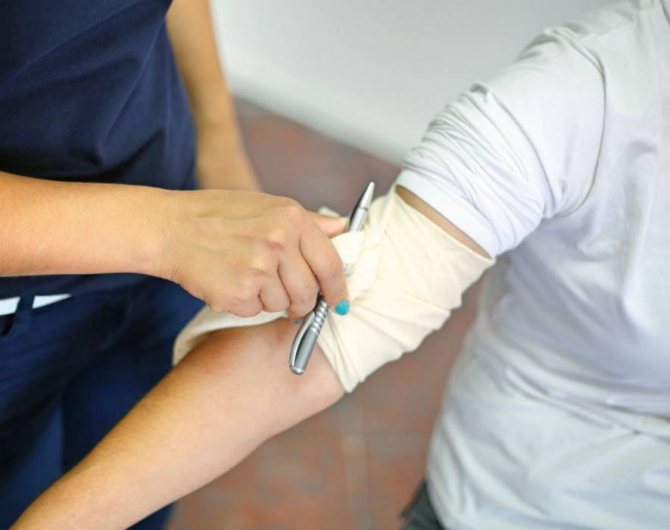
Do not use rope or wire for a twist cord.
The stick is fixed with a rope above the place where the tourniquet is applied to the limb, also with double knots. A note is placed under the tourniquet indicating the exact time of application of the twist.
Thus, due to the direct threat to life that occurs with arterial bleeding, you need to act very quickly. The briefly described first aid rules will help you not to panic and, in an extreme situation, save someone’s life.
Maximum time for applying a tourniquet in winter and summer - features and technology
If a vessel is damaged and its integrity is compromised, blood begins to flow out at the site of injury to the vascular wall.
The most serious is considered to be damage to the artery (if heavy bleeding from it is not stopped in time, death can occur literally in 3 minutes), the mildest is damage to the capillary.
A tourniquet helps stop bleeding from a vein or artery (there is no point in using a tourniquet to compress smaller vessels). However, it is imposed on the condition that all other possible measures to stop the bleeding have been tried, and they have not coped with their task.
Disadvantages of a tourniquet
A tourniquet is applied to tighten the damaged vessel, but this manipulation carries certain health consequences:
- Compression of surrounding tissue.
- Constriction of adjacent vessels.
- Compression of nerve endings.
- Impaired tissue nutrition and oxygen delivery to the damaged part of the body.
What are the types of bleeding?
Hemorrhage is distinguished by the area of leakage:
- Internal - blood flows into the body and forms a hematoma.
- External - flows out.
Depending on the type of damaged vessel, bleeding occurs:
- Capillary. The safest and slowest. Blood elements usually form a clot themselves and thereby stop the bleeding. But it can also be life-threatening - in diseases that provoke a decrease in the function of coagulation in the blood (for example, hemophilia or von Willebrand disease).
- Arterial. The pulsation of a bright red blood stream is characteristic. This species is the most dangerous for life, because it leads to huge losses of blood supply in a short period of time. Consequences: pale blood, weakened pulse, low blood pressure, dizziness, gag reflex. If blood stops flowing to the brain, instant death occurs.
- Venous. Dark burgundy blood flows out smoothly, with only a slight pulsation possible. If a significantly large vein is damaged, then when you inhale, a negative pressure effect appears in the vessel with an increased risk of air embolism in the heart vessels or in the human brain.
Internal bleeding and its intensity are accurately determined only with the help of special equipment.
Emergency tourniquet application is necessary in the following circumstances:
- Bleeding from an artery cannot be stopped by other means.
- The limb is torn off.
- Anything foreign has gotten into the open wound; for this reason, pressing or simply applying pressure with a bandage is prohibited.
- Very strong intense hemorrhage.
Rules for applying a tourniquet
To apply a tourniquet to a bleeding artery according to all the rules, you must follow the sequence of actions:
- The part of the limb that is located above the injury site is wrapped in a towel or, if there is clothing, the folds of the material are straightened out. You should try to apply the tourniquet as close to the wound as possible from above, always not on the naked body, but on a fabric pad.
- The bleeding limb is placed in an elevated position.
- The tourniquet is brought under the lower limb and divided into 2 parts, the short part on the left and slightly longer on the right. The tourniquet stretches to the sides and then wraps around the limb, intersecting at the top. The long part of the tourniquet should lie above the short one and press it.
- The rounds following the first are superimposed without any stretch.
- The remaining ends of the tourniquet are tied or secured with a hook.
- If the tourniquet is applied correctly, the hemorrhage should stop, the peripheral pulsation should weaken, and the skin of the limb itself should turn pale.
- Transporting patients with a tourniquet applied is recommended only in a supine position.
If we talk about applying a tourniquet to a vein, then the vessel should not be compressed as hard as the artery, but it should be enough to stop the bleeding. In case of venous hemorrhage, the tourniquet is applied not above, but below the wound, approximately 8 cm. After applying the venous tourniquet, the pulsation of the artery located under the wound should remain.
If it is not possible to use a pharmaceutical rubber band, then you need to use any means that are suitable for this purpose that are at hand: a scarf, a belt, a scarf, etc.
How long can a tourniquet be applied?
The maximum time for applying an arterial tourniquet to a damaged vessel is considered to be 120 minutes, but this value may vary depending on the time of year and the age of the patient.
With longer application, the risk of necrosis (death) in tissue increases.
To avoid injury from exceeding the maximum time for applying a tourniquet, use a note indicating the date, time of application (accurate to the minute) and the name of the person who applied the tourniquet. To prevent the note from getting lost, it is placed directly under the bandage.
The maximum time for applying a venous tourniquet to a limb is 6 hours.
Features of the harness lining depending on the time of year
The maximum time for applying a tourniquet in winter is recommended to be half an hour less than in summer, i.e. in summer the standard is 120 minutes, and in winter only 90 minutes.
But this is provided that the tourniquet is periodically loosened (the artery is pressed with a finger at this time). The maximum continuous time for applying a tourniquet is 45 minutes in summer, 30 minutes in winter, after which you need to loosen the tourniquet for 5 minutes and fix it back.
In the cold winter season, you must not forget about the possibility of frostbite on the affected limb, so you need to insulate the area exposed for applying a tourniquet.
Age restrictions
If the child is under 3 years old, then applying a tourniquet to any part of the body is strictly prohibited! For such babies, only pressing the vessel with a finger is used.
Upon reaching the age of three, the maximum time for applying a tourniquet is 60 minutes in the summer. In this case, you need to loosen the tourniquet for 5 minutes after half an hour.
In winter, for children over 3 years of age, the maximum time for applying a tourniquet is only 30 minutes.
For older people there are no time restrictions. Therefore, for them the maximum time for applying a tourniquet is standard.
Source: https://FB.ru/article/387595/maksimalnoe-vremya-nalojeniya-jguta-zimoy-i-letom—osobennosti-i-tehnologiya


